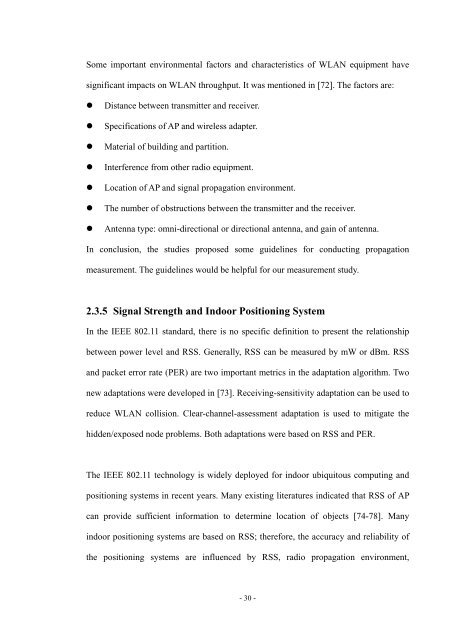An Investigation of the Impact of Signal Strength on Wi-Fi Link ...
An Investigation of the Impact of Signal Strength on Wi-Fi Link ...
An Investigation of the Impact of Signal Strength on Wi-Fi Link ...
Create successful ePaper yourself
Turn your PDF publications into a flip-book with our unique Google optimized e-Paper software.
Some important envir<strong>on</strong>mental factors and characteristics <str<strong>on</strong>g>of</str<strong>on</strong>g> WLAN equipment have<br />
significant impacts <strong>on</strong> WLAN throughput. It was menti<strong>on</strong>ed in [72]. The factors are:<br />
Distance between transmitter and receiver.<br />
Specificati<strong>on</strong>s <str<strong>on</strong>g>of</str<strong>on</strong>g> AP and wireless adapter.<br />
Material <str<strong>on</strong>g>of</str<strong>on</strong>g> building and partiti<strong>on</strong>.<br />
Interference from o<str<strong>on</strong>g>the</str<strong>on</strong>g>r radio equipment.<br />
Locati<strong>on</strong> <str<strong>on</strong>g>of</str<strong>on</strong>g> AP and signal propagati<strong>on</strong> envir<strong>on</strong>ment.<br />
The number <str<strong>on</strong>g>of</str<strong>on</strong>g> obstructi<strong>on</strong>s between <str<strong>on</strong>g>the</str<strong>on</strong>g> transmitter and <str<strong>on</strong>g>the</str<strong>on</strong>g> receiver.<br />
<str<strong>on</strong>g>An</str<strong>on</strong>g>tenna type: omni-directi<strong>on</strong>al or directi<strong>on</strong>al antenna, and gain <str<strong>on</strong>g>of</str<strong>on</strong>g> antenna.<br />
In c<strong>on</strong>clusi<strong>on</strong>, <str<strong>on</strong>g>the</str<strong>on</strong>g> studies proposed some guidelines for c<strong>on</strong>ducting propagati<strong>on</strong><br />
measurement. The guidelines would be helpful for our measurement study.<br />
2.3.5 <str<strong>on</strong>g>Signal</str<strong>on</strong>g> <str<strong>on</strong>g>Strength</str<strong>on</strong>g> and Indoor Positi<strong>on</strong>ing System<br />
In <str<strong>on</strong>g>the</str<strong>on</strong>g> IEEE 802.11 standard, <str<strong>on</strong>g>the</str<strong>on</strong>g>re is no specific definiti<strong>on</strong> to present <str<strong>on</strong>g>the</str<strong>on</strong>g> relati<strong>on</strong>ship<br />
between power level and RSS. Generally, RSS can be measured by mW or dBm. RSS<br />
and packet error rate (PER) are two important metrics in <str<strong>on</strong>g>the</str<strong>on</strong>g> adaptati<strong>on</strong> algorithm. Two<br />
new adaptati<strong>on</strong>s were developed in [73]. Receiving-sensitivity adaptati<strong>on</strong> can be used to<br />
reduce WLAN collisi<strong>on</strong>. Clear-channel-assessment adaptati<strong>on</strong> is used to mitigate <str<strong>on</strong>g>the</str<strong>on</strong>g><br />
hidden/exposed node problems. Both adaptati<strong>on</strong>s were based <strong>on</strong> RSS and PER.<br />
The IEEE 802.11 technology is widely deployed for indoor ubiquitous computing and<br />
positi<strong>on</strong>ing systems in recent years. Many existing literatures indicated that RSS <str<strong>on</strong>g>of</str<strong>on</strong>g> AP<br />
can provide sufficient informati<strong>on</strong> to determine locati<strong>on</strong> <str<strong>on</strong>g>of</str<strong>on</strong>g> objects [74-78]. Many<br />
indoor positi<strong>on</strong>ing systems are based <strong>on</strong> RSS; <str<strong>on</strong>g>the</str<strong>on</strong>g>refore, <str<strong>on</strong>g>the</str<strong>on</strong>g> accuracy and reliability <str<strong>on</strong>g>of</str<strong>on</strong>g><br />
<str<strong>on</strong>g>the</str<strong>on</strong>g> positi<strong>on</strong>ing systems are influenced by RSS, radio propagati<strong>on</strong> envir<strong>on</strong>ment,<br />
- 30 -
















